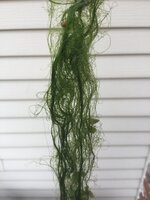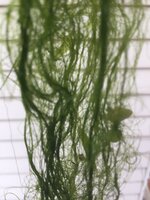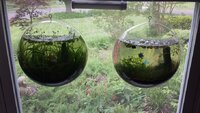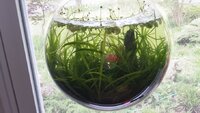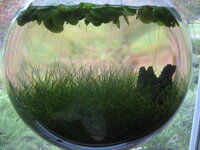I pulled this out every couple weeks from my Cherry shrimp jar that is non CO2, non liquid carbon, but receives strong window sunlight in the afternoon.. It’s long, silky and comes in entangled chunk. It’s bright green and can be attractive if it is only lightly infested as the shrimplets love to hang out. But it clogs up the jar every couple weeks and becomes a nuisance. Is it spirogyra and what’s the best way to get rid of other than physical removal.
-
You are viewing the forum as a Guest, please login (you can use your Facebook, Twitter, Google or Microsoft account to login) or register using this link: Log in or Sign Up
You are using an out of date browser. It may not display this or other websites correctly.
You should upgrade or use an alternative browser.
You should upgrade or use an alternative browser.
Is it spirogyra and how to get rid of
- Thread starter tiger15
- Start date
Edvet
Member
Looks like it.
I managed to make a dent in it by adding H2O2 ( i used 1 cc/ 3 lit tank), it looked like it made it palatable for cleaners more.
In the end i added a fauna snail wich cleaned the tank beautifully.
I managed to make a dent in it by adding H2O2 ( i used 1 cc/ 3 lit tank), it looked like it made it palatable for cleaners more.
In the end i added a fauna snail wich cleaned the tank beautifully.
What’s a fauna snail? I have both ramshorn and nerite snail, and they don’t do anything.Looks like it.
I managed to make a dent in it by adding H2O2 ( i used 1 cc/ 3 lit tank), it looked like it made it palatable for cleaners more.
In the end i added a fauna snail wich cleaned the tank beautifully.
Edvet
Member
Black devil snail: Faunus ater
(sorry my bad faunus not fauna)
(sorry my bad faunus not fauna)
Dolly Sprint 16v
Member
I pulled this out every couple weeks from my Cherry shrimp jar that is non CO2, non liquid carbon, but receives strong window sunlight in the afternoon.. It’s long, silky and comes in entangled chunk. It’s bright green and can be attractive if it is only lightly infested as the shrimplets love to hang out. But it clogs up the jar every couple weeks and becomes a nuisance. Is it spirogyra and what’s the best way to get rid of other than physical removal.
The issue is the strong afternoon sunlight - so move the shrimp jar so it not in direct sunlight if you cannot physical move it put something between the window and the jar to stop the sunlight getting ot the jar .
Cheers
Paul.
My front window is the best location for the shrimp bowls with no better alternatives from display perspective.The issue is the strong afternoon sunlight - so move the shrimp jar so it not in direct sunlight if you cannot physical move it put something between the window and the jar to stop the sunlight getting ot the jar .
Cheers
Paul.
I have two nearly identical shrimp bowls set up side by side for over a year. One has spirogyra, the other has none, and neither has any other algae. Both have fast growing floating frogbit, lush but slow growing dwarf hair grass in one, and dwarf Sag in the other. N and P levels are barely detectable for N and P in both. The only difference is the inhabitants. The spirogyra bowl has a breeding colony of cherry shrimp, the spirogyra free bowl has two Amano shrimp, and both have ramshorn, nirite and pond snails. Feeding schedule is identical, three 1 mm fish pellets a day.
My first suspicion is the inhabitants. I have 2 Amano in one, but a large colony of Cherry in the other. Don't cherry and amano eat the same type of algae?
My second suspicion is the feeding schedule. I had no spirogyra problem before I changed from feeding once a week to daily, same quantity. The reason I increased feeding is that my cherry did not multiply in lean feeding. Is it because the well fed Cherry get lazy and stop eating algae, but why is it not happening with the Amano?
Attachments
Edvet
Member
Mouthsize might influence diet, as may hunger.
zozo
Member
Lovely little bowls.. 😎
I have that alga all over the place in 2 indoor aquariums also having CHerry 1 outdoor aquarium and in 2 large outdoor tubs.. Plantmass doesn't realy make a difference also light is not the main factor it can grow extremely shaded. But 1 tub, the only one containing gold fish and full sun for biggest part off the day, it seems this algae doesn't get a chance to grow and eaten in very early stage. Maybe not eaten intirely but it doesn't grow much further than aufwugs i guess. 🙂
You can do H202 treatment which is very effective and turns it definitively into Cherry shrimp food. But wait and it'l be back. Few months for sure if its not eaten.
Amano's have it on their diet and black molly and platy also doesn't shy away from it. The rest of the poecilias i dunno but i guess they all snack it.
I have that alga all over the place in 2 indoor aquariums also having CHerry 1 outdoor aquarium and in 2 large outdoor tubs.. Plantmass doesn't realy make a difference also light is not the main factor it can grow extremely shaded. But 1 tub, the only one containing gold fish and full sun for biggest part off the day, it seems this algae doesn't get a chance to grow and eaten in very early stage. Maybe not eaten intirely but it doesn't grow much further than aufwugs i guess. 🙂
You can do H202 treatment which is very effective and turns it definitively into Cherry shrimp food. But wait and it'l be back. Few months for sure if its not eaten.
Amano's have it on their diet and black molly and platy also doesn't shy away from it. The rest of the poecilias i dunno but i guess they all snack it.
Cherry shrimp generally dont eat algae, they are bio film grazers which is why large, or small, shrimp populations need good supplimental feeding. I wouldn't advise daily feeding though, 3 times a week is generally plenty.
Why not clear the bowl and then add an amano to see if it solves the issue.
Sent from my SM-G950F using Tapatalk
Why not clear the bowl and then add an amano to see if it solves the issue.
Sent from my SM-G950F using Tapatalk
Dolly Sprint 16v
Member
Arh now we have a better picture of whats going wrong - the key thing to getting a correct diagnosis of algae issue is giving all relevant information ie tank position, lighting, fertz, planting regime and contents of aquariums.
What dosage of H2O2 do you administer that won’t kill the shrimp. I also heard API Algaefix will work, but I’m afraid it will kill my shrimp. So I prefer non herbicide H2O2 which I have already used to spot treat algae during WC in my high tech tanks.Lovely little bowls.. 😎
You can do H202 treatment which is very effective and turns it definitively into Cherry shrimp food. But wait and it'l be back. Few months for sure if its not eaten.
Amano's have it on their diet and black molly and platy also doesn't shy away from it. The rest of the poecilias i dunno but i guess they all snack it.
Platy and Molly are out of question as the bowl is only one gal, too small for any fish.
Cherry shrimp generally dont eat algae, they are bio film grazers which is why large, or small, shrimp populations need good supplimental feeding. I wouldn't advise daily feeding though, 3 times a week is generally plenty.
Why not clear the bowl and then add an amano to see if it solves the issue.
k
I’ll reduce feeding to perhaps once a week, and see how it goes. But they may stop multiplying, but winter is at the corner and they will slow down anyway.
I was considering introducing one Amano to the cherry bowl but am afraid the Amano will prey on the cherry. Once in, I wont be able to retrieve the Amano and thereby the mistake in the jungle of plants. If the cherry are in a larger container, I have no concern as one Amano can’t make a dent in the prolific cherry population.
zozo
Member
Only did it once in a tank with no fish but it had cherries and it all went ok. The algae turns pale and grey and melts away.
https://www.aquasabi.com/aquascaping-wiki_algae_hydrogen-peroxide-treatment
But as said. few months later is was back again.
https://www.aquasabi.com/aquascaping-wiki_algae_hydrogen-peroxide-treatment
But as said. few months later is was back again.
Thanks for the info. Returning a few months later is a big improvement, as currently I have to physically remove the spirogyra every couple weeks.Only did it once in a tank with no fish but it had cherries and it all went ok. The algae turns pale and grey and melts away.
https://www.aquasabi.com/aquascaping-wiki_algae_hydrogen-peroxide-treatment
But as said. few months later is was back again.
Just wonder if you remember the dosage you used that was safe for your shrimp. The link recommends a wide range from 8 to 35 ml 3% H2O2 per 50 liter.
It also says that it can be combined with EasyCarbo, which is Glut. Just wonder if Glut will work as good as or better than H2O2.
Even though I have dosed Glut and dry sprayed H2O2 in my big planted fish tanks many times, I am nervous to try the first time to dose my tiny shrimp bowl.
zozo
Member
I did it only once a few years ago in a neglected tank.. Don't actualy remember the dosage. Was a small tank and it wasn't much.
Search for the "one two punch" i believe planted tank.net forum has an extensive tutorial on from a few years back. That was the first time i red about the combination with glut.
Personaly i'm a nerd that looks and fidlles daily on my tanks. It's kinda therapy for my chaotic mind to rest.. I rather do it manual and neglaction is something not common in my husbandry schedule. 🙂 I guess i trained an eye for detail and recognize early small algae patches by color and pull it out. Works equaly effective..
Edit: Here it is
https://www.plantedtank.net/forums/23-algae/203684-one-two-punch-whole-tank-algae-treatment.html
Search for the "one two punch" i believe planted tank.net forum has an extensive tutorial on from a few years back. That was the first time i red about the combination with glut.
Personaly i'm a nerd that looks and fidlles daily on my tanks. It's kinda therapy for my chaotic mind to rest.. I rather do it manual and neglaction is something not common in my husbandry schedule. 🙂 I guess i trained an eye for detail and recognize early small algae patches by color and pull it out. Works equaly effective..
Edit: Here it is
https://www.plantedtank.net/forums/23-algae/203684-one-two-punch-whole-tank-algae-treatment.html
tam
Member
- Joined
- 5 May 2011
- Messages
- 1,560
I get it all wrapped around the roots of my floating plants... I keep meaning to do a test dunk in some easy carbo to see if I can remove n treat and return. I get bits around the rest of the tank but not so bad. It seems more opportunistic than other algae - I'm sure I've physically transferred it from tank to tank rather than just having it appear when conditions are off like most algae.


